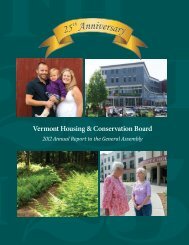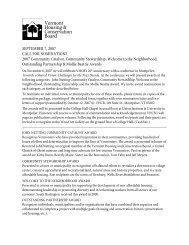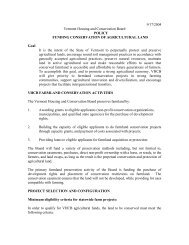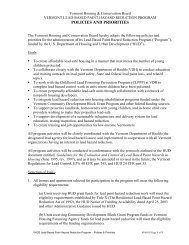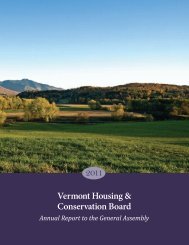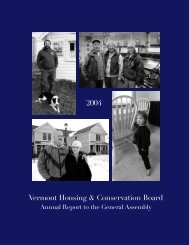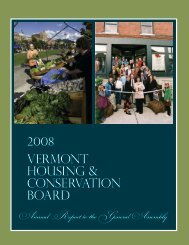Vermont Housing Conservation Board 2005 - Vermont Housing and ...
Vermont Housing Conservation Board 2005 - Vermont Housing and ...
Vermont Housing Conservation Board 2005 - Vermont Housing and ...
You also want an ePaper? Increase the reach of your titles
YUMPU automatically turns print PDFs into web optimized ePapers that Google loves.
BRIGGS FARM, ADDISON<br />
22<br />
JOINING A CONSERVED COMMUNITY<br />
In the Champlain Valley, Briggs Farm Is in Safe Company<br />
With more <strong>and</strong> more farml<strong>and</strong> protected in the Champlain Valley, this year’s<br />
transfer of development rights on Dale <strong>and</strong> Alma Briggs’s 485-acre place<br />
in Addison adds up to much more than a single conserved farm.<br />
The Briggs family farm, conserved with VHCB funding through the <strong>Vermont</strong><br />
L<strong>and</strong> Trust, joins two protected farms on adjacent l<strong>and</strong>. Overall, 5,431 acres of<br />
farml<strong>and</strong> have now been conserved in Addison town — that’s about 17 percent of<br />
the l<strong>and</strong>scape, according to VLT. Almost 47,000 acres are conserved in Addison<br />
County—most of which is productive farml<strong>and</strong>.<br />
“There’s getting to be a pretty good-sized block that’s been protected here — <strong>and</strong><br />
I think that’s the last hope for farms in <strong>Vermont</strong>,” says Dale Briggs. “It’s when the<br />
neighbors get close that problems begin to crop up. We’re not changing — cows<br />
still produce manure, they still eat food — but the neighborhoods around us are<br />
changing. If we can have some farms make a block, we can continue to farm without<br />
irritating too many people.”<br />
The Briggs are hoping to purchase some additional l<strong>and</strong> from a neighboring<br />
conserved farm with the proceeds from their sale of development rights. “That<br />
will give us some room to add some grain crops, <strong>and</strong> also to have some more room<br />
for manure, to meet the new regulations that are coming up,” Briggs says. “Try to<br />
continue. To survive.<br />
“There isn’t enough money in the farming economy now,” he adds. “This is one<br />
way to do the things you need to do.”<br />
“There’s getting to be a<br />
pretty good-sized block<br />
that’s been protected<br />
here — <strong>and</strong> I think that’s<br />
the last hope for farms<br />
in <strong>Vermont</strong>. ...We’re not<br />
changing — cows still<br />
produce manure, they<br />
still eat food — but the<br />
neighborhoods around<br />
us are changing. If we<br />
can have some farms<br />
make a block, we can<br />
continue to farm without<br />
irritating too many<br />
people.”<br />
— Dale Briggs<br />
Freestall barn at the 485-acre Briggs<br />
Farm, one of the largest farms in<br />
Addison. The family milks about 170<br />
cows, with a total herd of over 350.<br />
The Briggs till 410 acres <strong>and</strong> rent<br />
an additional 200 acres of cropl<strong>and</strong>.



